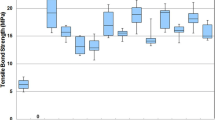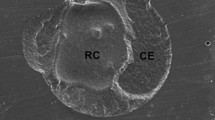Abstract
Because the use of hydrofluoric acid (HF) poses health risks if handled improperly, many clinicians prefer to have the ceramic restorations pre-etched in dental laboratories. However, during the try-in procedure, the pre-etched glass–ceramic restorations may be contaminated with saliva resulting in reduced bond strength. This in-vitro study aimed to investigate the effect of different surface treatments on the bond strength of lithium disilicate (LD) glass–ceramic restorations (IPS e.max Press, Ivoclar Vivadent) to two resin cements. One-hundred eighty blocks (4X4X3mm) of LD glass–ceramic were divided into twelve groups (n = 15), of which six received Variolink Esthetic DC (VE) cement and six received RelyX Ultimate (RU) cement, following the surface treatments: G1) Control: Hydrofluoric Acid + Silane (HF + Sil); G2) Hydrofluoric Acid + Saliva + Silane (HF + S + Sil); G3) Hydrofluoric Acid + Saliva + Ivoclean + Silane (HF + S + IC + Sil); G4) Hydrofluoric Acid + Saliva + Phosphoric Acid + Silane (HF + S + P + Sil); G5) Hydrofluoric Acid + Saliva + Monobond Etch & Prime (HF + S + EP); G6) Monobond Etch & Prime (EP). Following treatment, a resin-cement cylinder (2.3 mm diameter) was built on the glass–ceramic surface, photocured (20 s), stored in distilled water (37 °C, 24 h) and submitted to the shear bond strength test. Bond strength data (MPa) were subjected to two-way ANOVA and Tukey (α = 0.01). Cement type and surface treatment had a significant effect on the bond strength (p < 0.001) (Table 4). Single-step Monobond Etch & Prime (EP) significantly improved the bond strength of resin-cements to glass–ceramic with and without saliva contamination.


Similar content being viewed by others
Data availability
The datasets generated during and/or analysed during the current study are available from the corresponding author on reasonable request.
References
Guess PC, Schultheis S, Bonfante EA, et al. All-ceramic systems: laboratory and clinical performance. Dent Clin North Am. 2011;55(2):333–52.
Collares K, Corrêa MB, Laske M, et al. A practice-based research network on the survival of ceramic inlay/onlay restorations. Dent Mater. 2016;32(5):687–94.
Malament KA, Natto ZS, Thompson V, Rekow D, Eckert S, Weber HP. Ten-year survival of pressed, acid-etched e.max lithium disilicate monolithic and bilayered complete-coverage restorations: performance and outcomes as a function of tooth position and age. J Prosthet Dent. 2019;121(5):782–90.
Della Bona A, Anusavice KJ, Hood JA. Effect of ceramic surface treatment on tensile bond strength to a resin cement. Int J Prosthodont. 2002;15(3):248–53.
Lise DP, Perdigão J, Van Ende A, Zidan O, Lopes GC. Microshear bond strength of resin cements to lithium disilicate substrates as a function of surface preparation. Oper Dent. 2015;40(5):524–32.
Tian T, Tsoi JK, Matinlinna JP, Burrow MF. Aspects of bonding between resin luting cements and glass ceramic materials. Dent Mater. 2014;30(7):e147–62.
Giordano R, McLaren EA. Ceramics overview: classification by microstructure and processing methods. Compend Contin Educ Dent. 2010;31(9):682–700.
Santos MJ, Costa MD, Rubo JH, Pegoraro LF, Santos GC Jr. Current all-ceramic systems in dentistry: a review. Compend Contin Educ Dent. 2015;36(1):31–40.
Moreno MBP, Murillo-Gómez F, de Goes MF. Physicochemical and morphological characterization of a glass ceramic treated with different ceramic primers and post-silanization protocols. Dent Mater. 2019;35(8):1073–81.
Tribst J, Anami LC, Özcan M, Bottino MA, Melo RM, Saavedra G. Self-etching primers vs acid conditioning: impact on bond strength between ceramics and resin cement. Oper Dent. 2018;43(4):372–9.
Dimitriadi M, Zinelis S, Zafiropoulou M, Silikas N, Eliades G. Self-etch silane primer: reactivity and bonding with a lithium disilicate ceramic. Materials (Basel). 2020;13(3):641.
Lyann SK, Takagaki T, Nikaido T, et al. Effect of different surface treatments on the tensile bond strength to lithium disilicate glass ceramics. J Adhes Dent. 2018;20(3):261–8.
Sundfeld Neto D, Naves LZ, Costa AR, et al. The effect of hydrofluoric acid concentration on the bond strength and morphology of the surface and interface of glass ceramics to a resin cement. Oper Dent. 2015;40(5):470–9.
Höller B, Belli R, Petschelt A, Lohbauer U, Zorzin JI. Influence of simulated oral conditions on different pretreatment methods for the repair of glass-ceramic restorations. J Adhes Dent. 2022;24(1):57–66.
Alrahlah A, Awad M, Vohra F, Al-Mudahi A, Al Jeaidi Z, Elsharawy M. Effect of self-etching ceramic primer and universal adhesive on bond strength of lithium disilicate ceramic. J Adhes Sci Technol. 2017;31(23):2611–9.
Cardenas AFM, Quintero-Calderon AS, Siqueira FSF, et al. Do different application modes improve the bonding performance of self-etching ceramic primer to lithium disilicate and feldspathic ceramics? J Adhes Dent. 2019;21(4):319–27.
Dapieve KS, Machry RV, Pilecco RO, et al. One-step ceramic primer as surface conditioner: effect on the load-bearing capacity under fatigue of bonded lithium disilicate ceramic simplified restorations. J Mech Behav Biomed Mater. 2020;104: 103686.
El-Damanhoury HM, Gaintantzopoulou MD. Self-etching ceramic primer versus hydrofluoric acid etching: etching efficacy and bonding performance. J Prosthodont Res. 2018;62(1):75–83.
Guimarães H, Cardoso P, Decurcio R, Monteiro L, de Almeida L, Martins W, et al. Simplified surface treatments for ceramic cementation: use of universal adhesive and self-etching ceramic primer. Int J Biomater. 2018;2018:2598073.
Lopes GC, Perdigão J, Baptista D, Ballarin A. Does a self-etching ceramic primer improve bonding to lithium disilicate ceramics? Bond strengths and FESEM analyses. Oper Dent. 2019;44(2):210–8.
Maier E, Bordihn V, Belli R, et al. New approaches in bonding to glass-ceramic: self-etch glass-ceramic primer and universal adhesives. J Adhes Dent. 2019;21(3):209–17.
Nihei T, Kurata S, Kondo Y, Umemoto K, Yoshino N, Teranaka T. Enhanced hydrolytic stability of dental composites by use of fluoroalkyl trimethoxy silanes. J Dent Res. 2002;81(7):482–6.
Prado M, Prochnow C, Marchionatti AME, Baldissara P, Valandro LF, Wandscher VF. Ceramic surface treatment with a single-component primer: resin adhesion to glass ceramics. J Adhes Dent. 2018;20(2):99–105.
Román-Rodríguez JL, Perez-Barquero JA, Gonzalez-Angulo E, Fons-Font A, Bustos-Salvador JL. Bonding to silicate ceramics: conventional technique compared with a simplified technique. J Clin Exp Dent. 2017;9(3):e384–6.
Salem S, Ziada A, Elbanna K. Effect of two different surface treatments on micro-shear bond strength of CAD/CAM and heat pressed glass ceramics. Egypt Dent J. 2019;65(2):1853–64.
Scherer MM, Prochnow C, Venturini AB, et al. Fatigue failure load of an adhesively cemented lithium disilicate glass-ceramic: conventional ceramic etching vs etch and prime one-step primer. Dent Mater. 2018;34(8):1134–43.
Schestatsky R, Zucuni CP, Venturini AB, et al. CAD-CAM milled versus pressed lithium-disilicate monolithic crowns adhesively cemented after distinct surface treatments: fatigue performance and ceramic surface characteristics. J Mech Behav Biomed Mater. 2019;94:144–54.
de Siqueira F, Cardenas A, Gruber YL, et al. Using CAD/CAM-modified correlation mode to produce laminate veneers: a six-month case report. Oper Dent. 2017;42(5):E139–47.
Siqueira FS, Alessi RS, Cardenas AF, et al. New single-bottle ceramic primer: 6-month case report and laboratory performance. J Contemp Dent Pract. 2016;17(12):1033–9.
Siqueira FSF, Campos VS, Wendlinger M, et al. Effect of self-etching primer associated to hydrofluoric acid or silane on bonding to lithium disilicate. Braz Dent J. 2019;30(2):171–8.
Wille S, Lehmann F, Kern M. Durability of resin bonding to lithium disilicate and zirconia ceramic using a self-etching primer. J Adhes Dent. 2017;19(6):491–6.
Yang F, Zhu L, Han D, Li W, Chen Y, Wang X, et al. Effects of fluorine and silicon components on the hydrophobicity failure behavior of acrylic polyurethane coatings. J Coat Technol Res. 2017;14(3):691–9.
Bertolini JC. Hydrofluoric acid: a review of toxicity. J Emerg Med. 1992;10(2):163–8.
Yoshida K. Influence of cleaning methods on the bond strength of resin cement to saliva-contaminated lithium disilicate ceramic. Clin Oral Investig. 2020;24(6):2091–7.
Nikolaus F, Wolkewitz M, Hahn P. Bond strength of composite resin to glass ceramic after saliva contamination. Clin Oral Investig. 2013;17(3):751–5.
Phark JH, Duarte S Jr, Kahn H, Blatz MB, Sadan A. Influence of contamination and cleaning on bond strength to modified zirconia. Dent Mater. 2009;25(12):1541–50.
Scherrer SS, Cesar PF, Swain MV. Direct comparison of the bond strength results of the different test methods: a critical literature review. Dent Mater. 2010;26(2):e78-93.
Sirisha K, Rambabu T, Ravishankar Y, Ravikumar P. Validity of bond strength tests: a critical review-Part II. J Conserv Dent. 2014;17(5):420–6.
Murillo-Gómez F, Palma-Dibb RG, De Goes MF. Effect of acid etching on tridimensional microstructure of etchable CAD/CAM materials. Dent Mater. 2018;34(6):944–55.
Li R, Ma SQ, Zang CC, et al. Enhanced bonding strength between lithium disilicate ceramics and resin cement by multiple surface treatments after thermal cycling. PLoS One. 2019;14(7): e0220466.
de Kuijper MCFM, Gresnigt MMM, Kerdijk W, Cune MS. Shear bond strength of two composite resin cements to multiphase composite resin after different surface treatments and two glass-ceramics. Int J Esthet Dent. 2019;14(1):40–50.
Sagen MA, Kvam K, Ruyter EI, Rønold HJ. Debonding mechanism of zirconia and lithium disilicate resin cemented to dentin. Acta Biomater Odontol Scand. 2019;5(1):22–9.
Alkhurays M, Alqahtani F. Influence of different luting cements on the shear bond strength of pretreated lithium disilicate materials. J Contemp Dent Pract. 2019;20(9):1056–60.
Altintas S, Eldeniz AU, Usumez A. Shear bond strength of four resin cements used to lute ceramic core material to human dentin. J Prosthodont. 2008;17(8):634–40.
Alnassar T, Vohra F, Abualsaud H, Al-Thobity A, Flinton R. Efficacy of novel cleansing agent for the decontamination of lithium disilicate ceramics: a shear bond strength study. J Adhes Sci Technol. 2016;31(2):202–10.
Lapinska B, Rogowski J, Nowak J, Nissan J, Sokolowski J, Lukomska-Szymanska M. Effect of surface cleaning regimen on glass ceramic bond strength. Molecules. 2019;24(3):389.
Aladağ A, Elter B, Çömlekoğlu E, et al. Effect of different cleaning regimens on the adhesion of resin to saliva-contaminated ceramics. J Prosthodont. 2015;24(2):136–45.
Lyann SK, Takagaki T, Nikaido T, et al. Efficacy of various surface treatments on the bonding performance of saliva-contaminated lithium-disilicate ceramics. J Adhes Dent. 2019;21(1):51–8.
Völkel T, Braziulis E. Scientific documentation monobond etch & prime. Schaan: Ivoclar Vivadent AG; 2015. p. 1–22.
Chen C, Xie H, Song X, Burrow MF, Chen G, Zhang F. Evaluation of a commercial primer for bonding of zirconia to two different resin composite cements. J Adhes Dent. 2014;16(2):169–76.
Saboia VP, Silva FC, Nato F, et al. Analysis of differential artificial ageing of the adhesive interface produced by a two-step etch-and-rinse adhesive. Eur J Oral Sci. 2009;117(5):618–24.
Acknowledgements
The authors thank the laboratory technician Hirofumi Shirakawa for his excellent work during the fabrication of the ceramic specimens. The authors thank the group from the Departments of Biology and Statistical and Actuarial Sciences at Western University who performed the statistical analysis. The Schulich Dental Research Opportunity Program supported the student’s stipend.
Author information
Authors and Affiliations
Corresponding author
Ethics declarations
Conflict of interest
The authors declare no potential conflict of interest.
Additional information
Publisher's Note
Springer Nature remains neutral with regard to jurisdictional claims in published maps and institutional affiliations.
Rights and permissions
Springer Nature or its licensor (e.g. a society or other partner) holds exclusive rights to this article under a publishing agreement with the author(s) or other rightsholder(s); author self-archiving of the accepted manuscript version of this article is solely governed by the terms of such publishing agreement and applicable law.
About this article
Cite this article
Maqbool, B., Rego, H.M.C., Santos, G.C. et al. Effect of different surface treatment protocols on the bond strength between lithium disilicate and resin cements. Odontology 112, 74–82 (2024). https://doi.org/10.1007/s10266-023-00809-w
Received:
Accepted:
Published:
Issue Date:
DOI: https://doi.org/10.1007/s10266-023-00809-w




